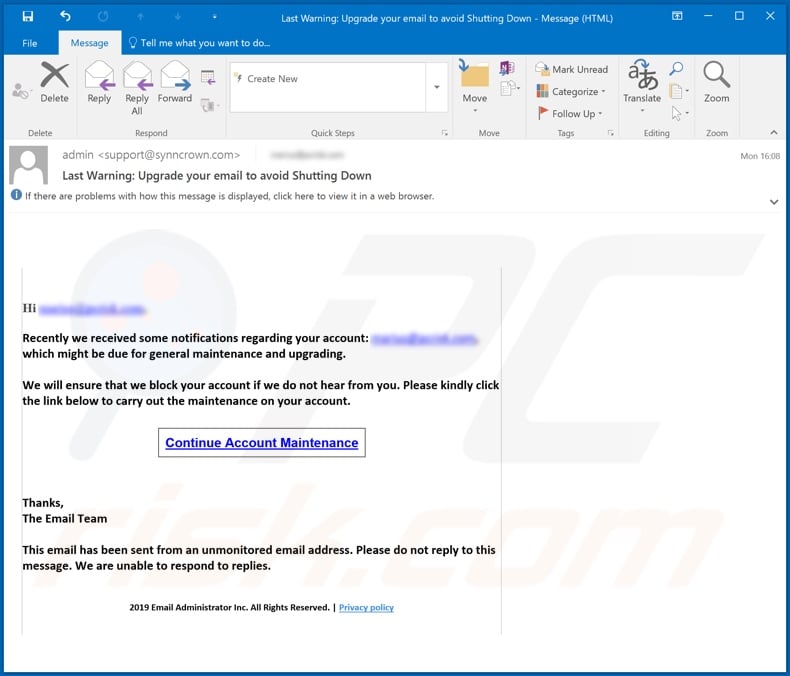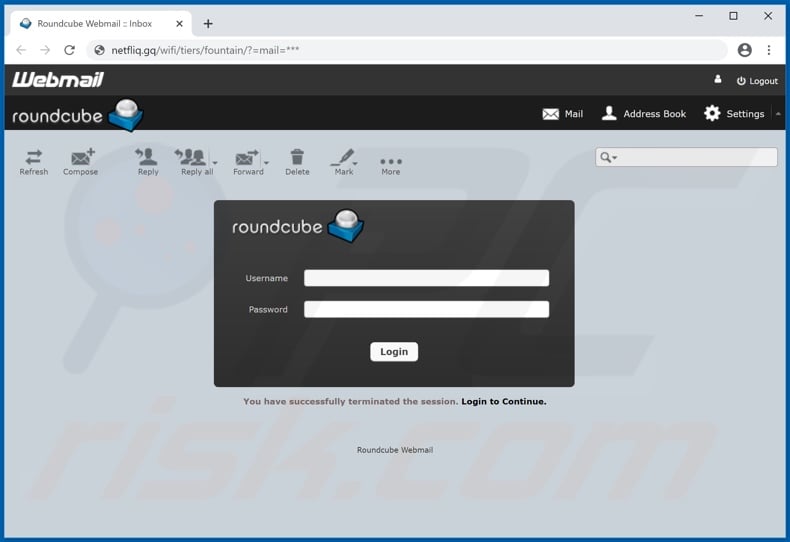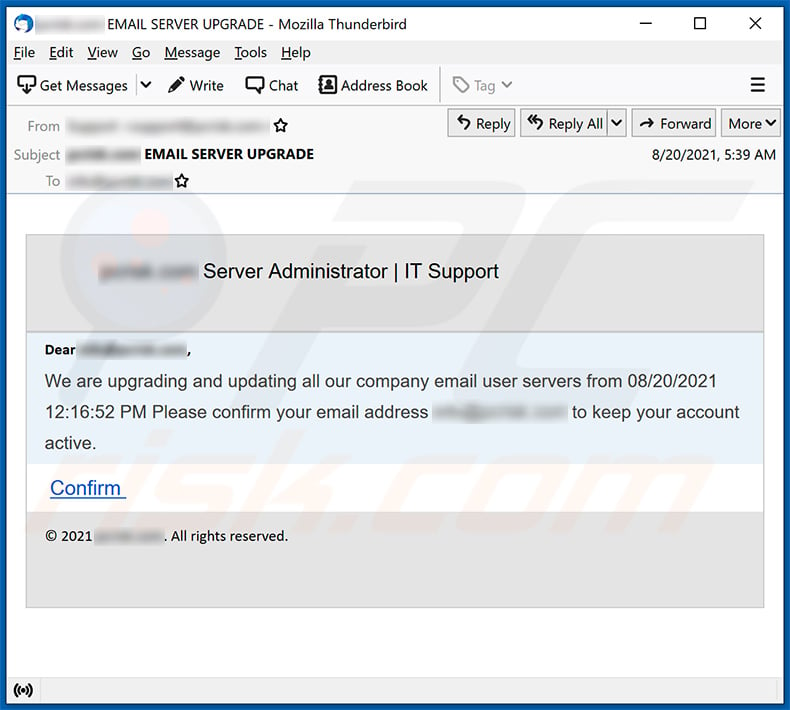Do not trust the "Last Warning: Upgrade your email to avoid Shutting Down" email
Phishing/ScamAlso Known As: Last Warning: Upgrade Your Email To Avoid Shutting Down spam
Get free scan and check if your device is infected.
Remove it nowTo use full-featured product, you have to purchase a license for Combo Cleaner. Seven days free trial available. Combo Cleaner is owned and operated by RCS LT, the parent company of PCRisk.com.
What kind of email is "Last Warning: Upgrade your email to avoid Shutting Down"?
"Last Warning: Upgrade your email to avoid Shutting Down" is the subject of a deceptive/scam email. The message is supposedly from the recipient's email administration team. It claims that the user's mail accounts might need to be upgraded. This scam steals the email accounts by tricking recipients into providing their log-in credentials.

"Last Warning: Upgrade your email to avoid Shutting Down" email scam overview
The "Last Warning: Upgrade your email to avoid Shutting Down" is allegedly an automated email sent by an unspecified "email team". It states that several notifications have been received concerning the user's mail account. These fake alerts may have been generated due to the account lacking general maintenance and the latest updates.
The message urges recipients to click the link "presented below" to fix these supposed issues. It also warns users that if they fail to respond (i.e., visit the website by clicking the link), the "email team" will block the email account. The button redirects to a phishing website, which imitates an email log-in page.
Entering any credentials into this web page will grant the scammers access to the corresponding email account. The threats posed by this scam are more than just loss of an email account. To elaborate, through compromised mails, other connected accounts (e.g. social networking and media, e-commerce, etc.) might be stolen and misused in various ways.
If attempts to log-in through this site have already been made, you are strongly advised to take immediate security measures, such as changing passwords of the email account and other linked accounts. You are also advised to contact official support of all potentially compromised accounts.
| Name | Last Warning: Upgrade your email to avoid Shutting Down Email Scam. |
| Threat Type | Phishing, Scam, Social Engineering, Fraud. |
| Fake Claim | Email claims that the recipient's email account requires maintenance. |
| Disguise | Email is disguised as an alert from the recipient's email administration team. |
| Related Domains | netfliq[.]gq |
| Detection Names (netfliq[.]gq) |
Avira no cloud (Phishing), BitDefender (Malware), Dr.Web (Malicious), Fortinet (Malware), Full List Of Detections (VirusTotal) |
| Symptoms | Unauthorized online purchases, changed online account passwords, identity theft, illegal access of the computer. |
| Distribution methods | Deceptive emails, rogue online pop-up ads, search engine poisoning techniques, misspelled domains. |
| Damage | Loss of sensitive private information, monetary loss, identity theft. |
| Malware Removal (Windows) |
To eliminate possible malware infections, scan your computer with legitimate antivirus software. Our security researchers recommend using Combo Cleaner. Download Combo CleanerTo use full-featured product, you have to purchase a license for Combo Cleaner. 7 days free trial available. Combo Cleaner is owned and operated by RCS LT, the parent company of PCRisk.com. |
Spam campaigns in general
Deceptive emails are sent via large scale spam campaigns. "You have 46 Hours in order to make the payment", "AOL Winner", "IFC Global Development Funding Program" are some examples of other scam messages. They are usually disguised as "official", "urgent", "important" or otherwise "priority" mail.
Social engineering and scare tactics are often used to trick users into performing specific actions. For example, opening infectious files, revealing personal and sensitive information (credentials of accounts, etc.), paying bogus fees and making other monetary transactions, and so on.
How do spam campaigns infect computers?
System infections are caused through dangerous files attached to or linked inside deceptive/scam emails. These messages are sent by the thousand - and such operations are called "spam campaigns".
Infectious files can be in various formats: Microsoft Office and PDF documents, archive (ZIP, RAR) and executable (.exe, .run) files, JavaScript and others. When they are opened, the infection process starts and they are triggered to begin downloading/installing malware (e.g. trojans, ransomware, etc.).
For example, MS Office documents cause infectious by executing malicious macro commands. Upon opening, these documents ask users to enable the macro commands (i.e., to enable editing). If enabled, the infection begins. In Microsoft Office programs released prior to 2010, however, download/installation of malware begins once the dangerous document is opened.
How to avoid installation of malware
To avoid malware infections via spam campaigns, suspicious and/or irrelevant emails should not be opened (especially, those received from unknown or suspicious senders). Any attachments or links present in dubious messages must never be opened, as they are the potential origin of a high-risk infection.
You are advised to use Microsoft Office versions released after 2010, since these newer versions have "Protected View" mode, which prevents infectious documents from initiating infection processes. When rogue files are opened, however, malicious software can also proliferate through untrusted download channels, illegal activation ("cracking") tools and third party updaters.
Therefore, use official and verified download sources, as opposed to free file-hosting websites, Peer-to-Peer sharing networks and other third party downloaders. Activate and update programs with tools/functions provided by legitimate developers. To ensure device and user safety, have a reputable anti-virus/anti-spyware suite installed and kept up to date.
Use this to perform regular system scans and for the removal of detected threats/issues. If you have already opened malicious attachments, we recommend running a scan with Combo Cleaner Antivirus for Windows to automatically eliminate infiltrated malware.
Text presented in the "Last Warning: Upgrade your email to avoid Shutting Down" email message:
Subject: Last Warning: Upgrade your email to avoid Shutting Down
Hi ****,
Recently we received some notifications regarding your account: ****, which might be due for general maintenance and upgrading.
We will ensure that we block your account if we do not hear from you. Please kindly click the link below to carry out the maintenance on your account.
Continue Account Maintenance
Thanks,
The Email TeamThis email has been sent from an unmonitored email address. Please do not reply to this message. We are unable to respond to replies.
2019 Email Administrator Inc. All Rights Reserved. | Privacy policy
Screenshot of the phishing website to which the link presented in this email redirects:

Another example of email upgrading-themed spam:

Text presented within:
Subject: ******** EMAIL SERVER UPGRADE
******** Server Administrator | IT Support
Dear ********,We are upgrading and updating all our company email user servers from 08/20/2021 12:16:52 PM Please confirm your email address ******** to keep your account active.
Confirm© 2021 ********. All rights reserved.
Instant automatic malware removal:
Manual threat removal might be a lengthy and complicated process that requires advanced IT skills. Combo Cleaner is a professional automatic malware removal tool that is recommended to get rid of malware. Download it by clicking the button below:
DOWNLOAD Combo CleanerBy downloading any software listed on this website you agree to our Privacy Policy and Terms of Use. To use full-featured product, you have to purchase a license for Combo Cleaner. 7 days free trial available. Combo Cleaner is owned and operated by RCS LT, the parent company of PCRisk.com.
Quick menu:
- What is Last Warning: Upgrade Your Email To Avoid Shutting Down spam?
- Types of malicious emails.
- How to spot a malicious email?
- What to do if you fell for an email scam?
Types of malicious emails:
![]() Phishing Emails
Phishing Emails
Most commonly, cybercriminals use deceptive emails to trick Internet users into giving away their sensitive private information, for example, login information for various online services, email accounts, or online banking information.
Such attacks are called phishing. In a phishing attack, cybercriminals usually send an email message with some popular service logo (for example, Microsoft, DHL, Amazon, Netflix), create urgency (wrong shipping address, expired password, etc.), and place a link which they hope their potential victims will click on.
After clicking the link presented in such email message, victims are redirected to a fake website that looks identical or extremely similar to the original one. Victims are then asked to enter their password, credit card details, or some other information that gets stolen by cybercriminals.
![]() Emails with Malicious Attachments
Emails with Malicious Attachments
Another popular attack vector is email spam with malicious attachments that infect users' computers with malware. Malicious attachments usually carry trojans that are capable of stealing passwords, banking information, and other sensitive information.
In such attacks, cybercriminals' main goal is to trick their potential victims into opening an infected email attachment. To achieve this goal, email messages usually talk about recently received invoices, faxes, or voice messages.
If a potential victim falls for the lure and opens the attachment, their computers get infected, and cybercriminals can collect a lot of sensitive information.
While it's a more complicated method to steal personal information (spam filters and antivirus programs usually detect such attempts), if successful, cybercriminals can get a much wider array of data and can collect information for a long period of time.
![]() Sextortion Emails
Sextortion Emails
This is a type of phishing. In this case, users receive an email claiming that a cybercriminal could access the webcam of the potential victim and has a video recording of one's masturbation.
To get rid of the video, victims are asked to pay a ransom (usually using Bitcoin or another cryptocurrency). Nevertheless, all of these claims are false - users who receive such emails should ignore and delete them.
How to spot a malicious email?
While cyber criminals try to make their lure emails look trustworthy, here are some things that you should look for when trying to spot a phishing email:
- Check the sender's ("from") email address: Hover your mouse over the "from" address and check if it's legitimate. For example, if you received an email from Microsoft, be sure to check if the email address is @microsoft.com and not something suspicious like @m1crosoft.com, @microsfot.com, @account-security-noreply.com, etc.
- Check for generic greetings: If the greeting in the email is "Dear user", "Dear @youremail.com", "Dear valued customer", this should raise suspiciousness. Most commonly, companies call you by your name. Lack of this information could signal a phishing attempt.
- Check the links in the email: Hover your mouse over the link presented in the email, if the link that appears seems suspicious, don't click it. For example, if you received an email from Microsoft and the link in the email shows that it will go to firebasestorage.googleapis.com/v0... you shouldn't trust it. It's best not to click any links in the emails but to visit the company website that sent you the email in the first place.
- Don't blindly trust email attachments: Most commonly, legitimate companies will ask you to log in to their website and to view any documents there; if you received an email with an attachment, it's a good idea to scan it with an antivirus application. Infected email attachments are a common attack vector used by cybercriminals.
To minimise the risk of opening phishing and malicious emails we recommend using Combo Cleaner Antivirus for Windows.
Example of a spam email:

What to do if you fell for an email scam?
- If you clicked on a link in a phishing email and entered your password - be sure to change your password as soon as possible. Usually, cybercriminals collect stolen credentials and then sell them to other groups that use them for malicious purposes. If you change your password in a timely manner, there's a chance that criminals won't have enough time to do any damage.
- If you entered your credit card information - contact your bank as soon as possible and explain the situation. There's a good chance that you will need to cancel your compromised credit card and get a new one.
- If you see any signs of identity theft - you should immediately contact the Federal Trade Commission. This institution will collect information about your situation and create a personal recovery plan.
- If you opened a malicious attachment - your computer is probably infected, you should scan it with a reputable antivirus application. For this purpose, we recommend using Combo Cleaner Antivirus for Windows.
- Help other Internet users - report phishing emails to Anti-Phishing Working Group, FBI’s Internet Crime Complaint Center, National Fraud Information Center and U.S. Department of Justice.
Frequently Asked Questions (FAQ)
Why did I receive this email?
Spam emails are not personal. Cyber criminals distribute these letters in large-scale campaigns; hence, thousands of users receive identical messages.
I have provided my personal information when tricked by this spam email, what should I do?
If you have provided log-in credentials - change the passwords of all potentially compromised accounts and inform their official support without delay. And if you've disclosed other private data (e.g., ID card details, credit card numbers, etc.) - immediately contact the corresponding authorities.
I have read a spam email but didn't open the attachment, is my computer infected?
No, opening/reading a spam email will not jumpstart any malware download/installation chains. Systems are infected when the attachments or links present in these emails are opened/clicked.
I have downloaded and opened a file attached to a spam email, is my computer infected?
Whether an infection was triggered might depend on the opened file's format. If it was an executable - most likely, yes - your device was infected. However, document formats (.pdf, .xls, .doc, etc.) may require additional user interaction (e.g., enabling macro commands) to start downloading/installing malicious software.
Will Combo Cleaner remove malware infections present in email attachments?
Yes, Combo Cleaner can detect and eliminate almost all known malware infections. It has to be stressed that running a full system scan is crucial - since high-end malicious programs tend to hide deep within systems.
Share:

Tomas Meskauskas
Expert security researcher, professional malware analyst
I am passionate about computer security and technology. I have an experience of over 10 years working in various companies related to computer technical issue solving and Internet security. I have been working as an author and editor for pcrisk.com since 2010. Follow me on Twitter and LinkedIn to stay informed about the latest online security threats.
PCrisk security portal is brought by a company RCS LT.
Joined forces of security researchers help educate computer users about the latest online security threats. More information about the company RCS LT.
Our malware removal guides are free. However, if you want to support us you can send us a donation.
DonatePCrisk security portal is brought by a company RCS LT.
Joined forces of security researchers help educate computer users about the latest online security threats. More information about the company RCS LT.
Our malware removal guides are free. However, if you want to support us you can send us a donation.
Donate
▼ Show Discussion